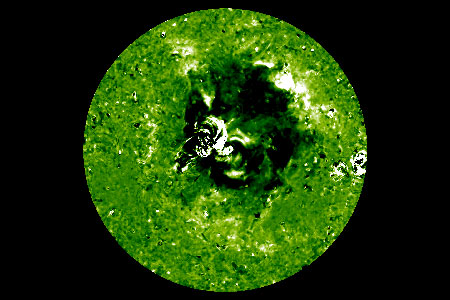Remarkable Images of Tsunami Sweeping Across the Sun Shown by TCD Astrophysicists
Posted on: 03 April 2008
Images captured by NASA’s twin STEREO spacecrafts show for the first time, a solar tsunami blasting its way through the Sun’s lower atmosphere. The discovery was presented by David Long of the TCD Astrophysics Research Group School of Physics at the RAS National Astronomy Meeting in Belfast on April 2nd last.
Solar tsunamis are launched by huge explosions near the Sun’s atmosphere, called coronal mass ejections. Although solar tsunamis share much in common with tsunamis on Earth, the solar version can travel at over a million kilometres per hour.
The tsunami took place on May 19th 2007, and lasted for about 35 minutes, reaching peak speeds around 20 minutes after the initial blast. The observations were made by the TCD Astrophysics Research Group led by David Long.
“The energy released in these explosions is phenomenal, about two billion times the annual world energy consumption in just a fraction of a second. In half an hour, we saw the tsunami cover almost the full disc of the Sun, nearly a million kilometres away from the epicentre,” explained the TCD researcher, David Long.
Extreme Ultraviolet Imager (EUVI) instruments in STEREO’s twin spacecrafts monitor the Sun at four wavelengths which correspond to temperatures ranging between 60,000 and 2 million degrees Celsius. At the lowest of these temperatures, scientists can see structures in the chromosphere, a thin layer of the solar atmosphere that lies just above the Sun’s visible surface. At temperatures between 1 and 2 million degrees Celsius, scientists can monitor features at varying levels in the solar corona.
STEREO’s EUVI instruments take an image every few minutes to create a series, making it possible for scientists to track how the wave spreads over time.
This is the first time that a tsunami has been observed at all four wavelengths, which enabled the team to see how the wave moved through the different layers of the solar atmosphere.
“To our surprise, the tsunami seems to move with similar speed and acceleration through all the layers. As the chromosphere is much denser than the corona, we’d expect the pulse there to drag. It’s a real puzzle,” said TCD Astrophysics Lecturer, Dr Peter Gallagher.
“We’ve thought for some time that the tsunamis might be caused by magnetic shockwaves but, in previous snapshots, the waves appeared to be travelling too slowly. However, we’ve seen from this set of observations that if the time interval between images is too long, it’s easy to underestimate the speed that the waves are moving. With a few more rapid-sequence observations of solar tsunamis, we should finally be able to identify the cause of these waves,” concluded Dr Gallagher.

Background Information:
STEREO
The Solar Terrestrial Relations Orbiter (STEREO) is a NASA-led mission, with major contributions from European countries including the UK. The mission consists of two space-based observatories, one ahead of Earth in its orbit and the other trailing behind.
